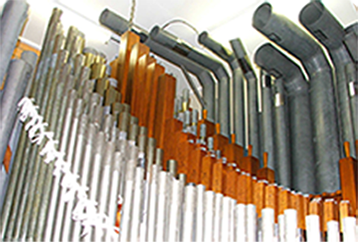By Paul Citti
Originally printed in the Jan/Feb 2023 edition of Pedals and Pipes Newsletter
Enjoying his new found success, De Kleist began to neglect his duties at the factory so Wurlitzer ended up buying him out and reincorporated absorbing the De Kleist Company and keeping just the Wurlitzer name. By this time, Rudolf’s older son Howard played a major role in running the company. His younger brother Farny was sent to Germany to learn the German language and manufacturing techniques. While there he cultivated a partnership with Phillips Company, a manufacturer of Orchestrians which were large ornate cabinets containing a piano, organ pipes and percussions playable via paper rolls and could be coin operated. Wurlitzer ordered some in which Phillips received cash up front. Seeing the potential for success Wurlitzer wanted to purchase them on account as this would increase the volume of sales. To prove they were credit worthy Wurlitzer presented Phillips with their impeccable bank and financial statements. However Phillips still declined so Rudolf and son Howard went off to Germany and visited the town were Phillips was located and rented the most lavish hotel suite and traveled about in a fine carriage and team of horses. All this ostentatious display of wealth persuaded Phillips to sell to them on credit. When Farny returned to America, in 1909 he became head of the factory at North Tonawanda NY where their next major product was developed called the Pianino. This was the first coin-operated piano using paper rolls with auto rewind. Other automated instruments followed such as harps, mandolins and orchestrians. Along came many variations and models but all of this growth equipped them with the capital and manufacturing expertise needed to tackle their biggest project to date that cemented their name forever in the history of American Music, the creation of the Mighty Wurlitzer Theater Pipe Organ; enter Robert-Hope Jones. In 1910, Wurlitzer formed a partnership with Robert Hope-Jones, a British engineer who came to America opening a pipe organ factory in Elmira NY. Utilizing his patents and experience they created the Unit Orchestra, a pipe organ that would be able to accompany silent-movies as this was a growing market with larger theaters being built. However, HopeJones proved to be a hindrance to production by constantly making changes and experimenting, a problem that caused his own company to flounder and go bankrupt. To solve this problem, he was barred from the factory and was told that once the organs started to generate a profit, they would provide him with a research laboratory in the factory. Instead he committed suicide. Well, what is common knowledge is that they did generate a profit as Wurlizter became the largest producer of theater pipe organs in the world with peak production in 1926. Unfortunately Rudolf passed away in 1914 and did not see the success they attained in this market. His eldest son Howard passed away in 1928 and from this point on the company was headed by Farny with help of his other brother Rudolf Jr. who headed the rare violin collection at the NYC store. After theater organs were no longer needed they focused more on piano production with a partnership with Melville Clark and produced the first spinet piano. When prohibition ended in the 1930s, Farny in 1933 purchased patents for the Sampled Mechanism from Homer E. Caprehart and utilizing the design talents of Paul Fuller, created the jukebox as we know it today and coupled with their aggressive advertisement campaign featuring the song “Johnny One Note”, the name Wurlitzer and jukeboxes became inseparable. Further down the line in the 1950s, Wurlitzer harnessed the talents of inventor /Radio Engineer Benjamin Miessner to develop an electronic piano. Using traditional piano keys that struck steel reeds that in turn were amplified though a speaker produced an instrument that possessed touch sensitivity like a regular piano, did not need to be tuned and was in most models portable. This piano gained popularity among schools especially for group piano class in which the teacher and students wore headphones and the teacher could speak to any student individually via headset. As many as 48 pianos could be connected to this system. From this point on, Wurlitzer continued to produce many varieties of pianos and electronic organs that sold well into the late 1970s. In May of 1972, Farny the only surviving child of Rudolf and Leonie passed away at age 88. His wife Grace passed away in 1968 and having no children, the bulk of his estate valued at approximately $3.5 million went to charity as in life they lived very generously. In conclusion, the music industry which is a very volatile market requires a good eye and ear to identify trends and Rudolf, Howard and Farny were adept at recognizing the ideas and talents of others and refining those ideas into a product that, with a well-structured advertising campaign, sold well and most important, made people happy. Imagine all the smiles that appeared as those nickel buffalo coins stampeded down the slots of those automated instruments which in turn gave birth to the “Mighty Wurlitzer” Theater Organ which is loved, played and appreciated even to this day, even by those young of age or young of heart.









